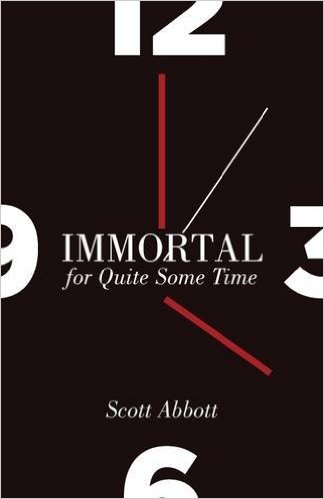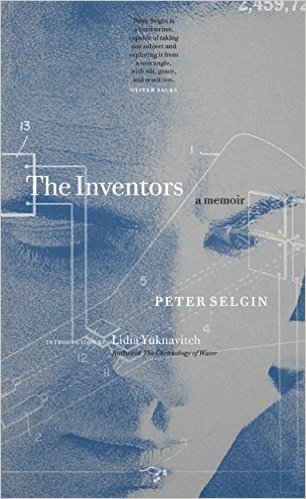You have /5 articles left.
Sign up for a free account or log in.
The Inventors. Peter Selgin. Hawthorne Books. 2016.
Immortal for Quite Some Time. Scott Abbott. University of Utah Press. 2016.
Review by John Domini
Memoir: a word, fittingly, out of the Romance languages. Not only does the form go back to Montaigne and La Rochefoucald (and Caesar before them), but also the current American variety tends to feature affairs of the heart. The memoirs that have lately become book-group staples, such as Mary Karr’s, generate a lot of what passes for plot and suspense by tracking the vagaries of love. Naturally the track takes perverse turns; happy families are all alike, but each unhappy family puts out a memoir. In Karr the embrace stinks of alcohol, and in Kathryn Harrison’s The Kiss, it’s incest.
Likewise intriguing, if less shocking, is the damaged love found in two new additions to these shelves. Both Peter Selgin’s The Inventors and Scott Abbott’s Immortal for Quite Some Time prove sensitive about the strange shapes that passion can take, as well as skillful about herding experience into narrative. Both work up engaging varieties of the book-length backward look.
 The material of Immortal actually shares some of the tabloid quality found in Harrison or Karr. Abbott grew up an observant Mormon, and in his case the church gave him the foundation for success. The book’s first chapter, setting up his chronological method, sketches a rising academic trajectory that docked eventually at tenure in the Humanities at Brigham Young; along the way he enlarges the LDS flock, marrying well and fathering seven children.
The material of Immortal actually shares some of the tabloid quality found in Harrison or Karr. Abbott grew up an observant Mormon, and in his case the church gave him the foundation for success. The book’s first chapter, setting up his chronological method, sketches a rising academic trajectory that docked eventually at tenure in the Humanities at Brigham Young; along the way he enlarges the LDS flock, marrying well and fathering seven children.
The author’s younger brother John, however, stumbles. By the end of his teens he can no longer deny his homosexuality. His mother may call her younger son “satanic,” but even on mission in Italy, John’s “flirtation” with one amico is impossible to mistake, in an old photo reproduced in the text. Yet while the picture is from the early 1970s, it takes ten more years for John to come out to his brother, and then only on neutral ground: a Unitarian church in Houston. Ten years further on, back in Utah but estranged from the family, a low-wage restaurant worker, John succumbs to AIDS. Another photo presents his gravestone, on which his dates stand out starkly. The man barely made it to 40.
Powerful stuff, as I say, this tragedy compels the older brother to “gather these fragments of history,” and head into “incalculable territory.” Abbot’s terra incognita includes this book, little like his previous scholarship, but more than that, given his place in the world, “to reach my brother I ... must risk obliteration as the self I have become.” Before long, the struggle to find a place for John in the tabernacle threatens his position at BYU—and by extension his marriage, as again romance provides an essential memoir-motor, creating drama over the book’s latter half.
Yet while Abbott’s faith and love life cool, other kinds of intensity never wane. Even as he rejects tenets of the church, he allows his mother to object; her interruptions, spiky and unyielding, appear in an alternative font. The effect, like many of the photos, is to sustain this philosophy professor’s love for “dialectical.” So too, though Abbott no longer enjoys his wife’s company, he never loses his appetite for sensual pleasure. He marries again, happily, and every camping trip prompts fresh celebration of the Utah landscape. So too, the text samples from a smorgasbord of tasty rhetoric, citing Dylan Thomas here and Edward Abbey there.
 Peter Selgin’s The Inventors brims with sensuality as well. One episode lingers over the bracing shiver of a dawn dip in a country lake; another explores the shameful chill of letting a “slimebucket” Broadway director, the same sex as the narrator, get his jollies on the casting couch. Dismaying or uplifting, such ripeness has a classic appeal, but it spices up a drama far from conventional.
Peter Selgin’s The Inventors brims with sensuality as well. One episode lingers over the bracing shiver of a dawn dip in a country lake; another explores the shameful chill of letting a “slimebucket” Broadway director, the same sex as the narrator, get his jollies on the casting couch. Dismaying or uplifting, such ripeness has a classic appeal, but it spices up a drama far from conventional.
The Inventors never has much trick with Aristotelian unities. Its home base is Bethel, Connecticut, an old light-industrial exurb, where back about 1970 the tween-aged author gets his first glimpses of adult mystery. He does solve those mysteries, in time, unveiling not only his father’s secret identity but also that of a favorite teacher—a man whose unorthodox ways both inspire and disturb. The discoveries unfold with some of the pleasure of a detective story, and yet throughout, the process allows for no simple payoff.
As puzzle pieces start falling into place, and childhood icons start to ring hollow, the text will throw in a pertinent reminder by way of Rilke: “every angel is terrible.” The search for answers strays a long way from greater New York, with layovers in skid row New Orleans and hippie Oregon. Even during stretches that otherwise stay in one place, and in sequence, the story will dart off for a couple of italicized pages (caveat lector: italics galore) set in Selgin’s present, in central Georgia, where he’s approaching 60 and teaching college.
More disorienting yet, though the contemporary passage will begin with hard sensory data, such as the play of wind chimes, it will conclude with a memoirist’s Uncertainty Principle: “by hook or by crook, often with the help of others, we all invent or reinvent ourselves.” Likewise those “others” all get their say, more even than in Immortal. Inventors delivers fine, nasty fun when an object of infatuation herself proves an “inventor,” coming up with a delicious new brand of torture. In so doing, she also gives our detective another clue (concerning the teacher, in this case), and later, after Selgin has found out all he can, he provides corroboration by a stroke I found brilliant. He hands off the closing pages to another writer altogether, getting a second opinion. So too, key revelations are made via dialogue, and some go so far as to dip into dialect. Selgin’s mother, even in her 80s, never loses the accent and idioms of an immigrant:
I ask him are you omosessuale an e say yes, Pinuccia. I say to eem I no give a goop if you ommosessuale. I know you a good man, I tell him, but I Peter mudder an I swear on God....
The recurring visuals, lifted from the diagrams that accompanied the father’s patent applications, create much the same effect. All squiggles, circles, and straight lines, they’re fascinating but incomprehensible. They too conduct the alternating current of mystery and solution, in a work that’s ostensibly “nonfiction” but must finally be counted Creative Writing.
Which is Selgin’s job, after all. He teaches the subject, these days, and he’s won awards in both fiction and drama, while also exhibiting as a painter. In this exercise, he’s sketching his Portrait of the Artist as a Young Man. Joyce’s novel may have been assigned by a teacher who asked too much of the boy, and got too close, but this man also forged his acolyte’s determination “to be an artist... recognized and admired for his bold, unique style.”
Abbott shares that ambition, to be sure; it’s one of the few landmarks in his “incalculable territory.” For what it’s worth, then, I ought to note that, of these memoirs, I preferred Selgin’s—but then I know a number of his locales, both the nooks for trysting and the spaces for prayer, much better than the landscape of Immortal. Both sojourns, however, reward the visitor while expanding the form.
***
Last summer John Domini brought out his latest book, short stories, MOVIEOLA!





